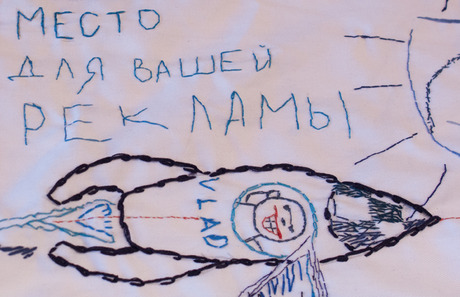
AUGUST 22 – SEPTEMBER 10, 2013
Spur / Trace is the first object to be created at the Zarya Center for Contemporary Art, as the material result of the eponymous performance by Yingmei Duan (Braunschweig) and Anna Parmenova and Valentina Pchelintseva (Vladivostok). On August 22, the artists invited both residents and visitors to the city alike to leave their “trace ” on the history of contemporary art. On the surface of a white canvas, a perfect tabula rasa, a new page in the history of the former garment factory, each visitor to the Zarya Center could leave a trace of their presence – their autograph or a mark or symbol that they associate with their life, their personality, and their perspective. All these “traces” were then recorded onto the canvas through hand-stitched embroidery. The artists spent more than two weeks, working 7 hours a day, to create this work.
This performance was inspired by the idea of “the monuments to friendship and communication,” the salon albums boasting collections of autographs, drawings and wishes that became an iconic fixture of the noble parlors of the 19th century, serving as centers for the circulation of the artistic ideas of the era. One of these collections – a tablecloth of green cloth, covered with over 70 autographs of Lev Tolstoy and his family – was embroidered by Tolstoy’s oldest daughter, Tatiana, during the years she spent with the family in Moscow, at the Khamovniki estate.
On the surface of this contemporary Trace, simple and easily-recognizable signifiers – a bicycle, a camera, a cat, a whale, an airplane, coffee, candy, a guitar, a car – are juxtaposed with surreal characters, memes, homegrown or international symbols of different subcultures (“For the Navy,” Pacific, emblems of the “Pirates of the Straw Hats” from the manga comic One Piece…), the logos of major multinationals (Toyota, Canon, Nike) and the private commercial initiatives of performance participants – sites, studios, agencies and stores.
Trace offers a way to collect a multisided portrait of the contemporary audience, to fix the signs of the times and the tropes of the future onto the “sacrificial” body of art, which is ready to take on whatever projections our imaginations can deliver. Trace is a call to reconsider the function of contemporary art. To compare it with fiction/PR, or, alternatively, with the secret “knowledge” of the world, through communication with the audience, to proclaim that old story about the emperor with no clothes as something new, or with the act of marring the best initiatives with the stamp of consumerism. At first glance, Trace appears as fact, a statement of the obvious. For the majority of us, life is built around kittens, dreams of world peace, and the wishes that their own small businesses would thrive. More rarely, intellectual interventions interrupt the format, reproducing corporate logos. Potentially good artists (one or two at most) leave unexpectedly beautiful and powerful visual metaphors for their own worldview, but these are not always evident on first (or even second) look.
An abstracted view is recommended, to distract from one’s personal judgement, to determine for one’s self what meaning may lie in these new forms of interaction between the artist and the viewer. Trace offers a chance to reflect on the mission of the artist. What is this object and the process that came before it? A new analytical method of portraiture, or a potent social gesture? An attempt to shift responsibility to the audience? Or an act of self-degradation on the part of the artist, the hero of our times, ready to submit the flesh of his art to the flood of joy, vulgarity, love or cynicism of our contemporaries? Over 250 “autographs” cover the surface of this canvas, a sign of the readiness of the viewer to change his or her passive relationship to art, to find him or herself in it, to play the role of con-artist – the artist’s idea (concepts), parts of the whole – or as a voice for the evident (as one of the performance participants did, when they gave the object a new name, clarifying its origin – “Your Ad Here.”)
YINGMEI DUAN (Born in 1969 in Daqing, China, lives and works in Braunschweig, Germany) Duan is one of the students of Marina Abramovic and Christophe Schlingensief, both internationally-renowned performance artists and laureates of the Venice Biennale’s prestigious “Golden Lion.” Having participated in numerous exhibitions and contemporary art festivals all over the world, Duan has dedicated the last 12 years of her life to performance, exploring primal fears, desires and motivations for human behaviour through long-durational performances. Each of Duan’s projects lasts anywhere from a few weeks to several months, attracting thousands of spectators and participants, whose reactions in turn lead the artist to new themes for her performance practice.
ANNA PARMENOVA (Born in 1983 in the Primorsky Krai, lives and works in Vladivostok) Parmenova trained in the painting faculty at the Vladivostok College of Art (2003), before studying at the Far East Academy of Art (2003-04) and graduating from the textile department at Saint Petersburg’s Stieglitz Academy of Art and Design (2011). At the present moment, she teaches artistic textile for interiors and fabric painting at the DVFU.